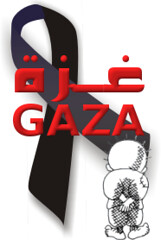Gaza farmers brave Israeli bullets
Rami Almeghari writing from the occupied Gaza Strip, Live from Palestine, 8 June 2009
 |
| Mustafa al-Buhairi's family are unable to work their land because of Israeli army threats. (Rami Almeghari) |
For more than six decades, the al-Buhairi has family lived on and farmed their land near the boundary with Israel, to the east of Maghazi refugee camp in the central Gaza Strip. Last week Israeli warplanes dropped leaflets warning individuals not to set foot in a 300-meter-wide (1,000 foot) strip of land on the Gaza side of the border.
"We have been here for many years planting peppers, watermelon and wheat," said Mustafa al-Buhairi, 38, standing amidst pepper plants near his home. But "after the last Israeli war against this region in January," he said, "we began to see new Israeli restrictions against our area."
In the last month, Israeli warplanes dropped thousands of similar leaflets on borderline communities from Rafah in the south of the Gaza Strip all the way to Beit Hanoun in the north.
"Suddenly, Israeli F-16 fighter jets made a loud noise then dropped a box that exploded in the sky spreading papers all over our farmland," al-Buhairi recalled.
Al-Buhairi voiced his anger over the Israeli measure explaining that his entire family, including his six children and two brothers, have been badly affected because they are unable to safely work their land.
Despite the risk, al-Buhairi said the family has to continue trying to farm the land because their livelihood depends on it "Yet we are working under risk," he said.
"Four days ago I was irrigating some olive trees which are located beyond the designated limit of 300 meters. Three bullets were shot from that military post on the hilltop," al-Buhairi said, indicating the direction. "One went to the left of me, one to the right and the third over my head."
The leaflets are accompanied by Israeli soldiers patrolling the border area with tanks and jeeps and surveilling the area from watchtowers.
The soldiers have shot at al-Buhairi and his family members with increasing frequency despite the fact that the family's house and land are about 700 meters (2,300 feet) from the border.
Al-Buhairi said the soldiers shoot even up to one kilometer from the border which has made it extremely difficult to harvest produce. He asserted that since the leaflets were dropped, production has fallen sharply.
Nevertheless, al-Buhairi and other farmers harvest their wheat, even under fire: "When they open fire we disappear, and when they stop, we come back."
The al-Buhairi family already lost half of its livestock as Israeli tanks shelled the area near the family home during last winter's invasion of Gaza.
"You see that rubble," al-Buhairi said, pointing to the remains of a building. "That used to be our livestock pen with more than 50 sheep. A tank shell destroyed it, killing 25 of them."
Al-Buhairi and his 80-year-old father echoed a similar sentiment: they had nowhere else to go during the Israeli attack. "We have no other choice, either we live here or we die here."
According to international organizations, the amount of damage on the border area in eastern Gaza Strip could not be properly assessed. The United Nations Food and Agriculture Organization (FAO) says that the area is too dangerous due to continued Israeli army actions and indiscriminate fire against such rural areas.
More than a decade ago, when Israeli occupation forces were present inside Gaza, rather than on the perimeter, Israel declared a one-kilometer buffer zone in an attempt to prevent attacks by resistance forces targeting border patrols.
The current 300-meter limit swallows more than 30 percent of Gaza's arable land, according to the FAO.
Rami Almeghari is a journalist and university lecturer based in the Gaza Strip.












